Fishing Report: Jan. 14, 2022

Offshore, mangrove snapper bite is on fire
Mangrove snapper action is fired up offshore right now. We are seeing some monster mangrove snapper in a big overall size while fishing deeper offshore waters, says Captain Dylan Hubbard of Hubbard's Marina.
MADEIRA BEACH, Fla. - Every Friday morning, Captain Dylan Hubbard of Hubbard's Marina joins Good Day to fill viewers in on his fishing forecast as we head into the weekend.
Here is his fishing report for January 14, 2022.
Weather effects on fishing
The full moon is here, and we have a strong front bearing down on us for the latter part of the weekend too. This means after the wind calms Friday you should get out on the water.
Fishing should be hot Friday afternoon and especially throughout the day Saturday. The best fishing around these fronts is always right before they come and then 2-4 days after they move through depending on their strength.
The backside of the front is harder to predict and depends more on the depth you fish, whether that area gets stirred up, and how badly it’s affected while the front moves through. However, right before the front is easier to predict and easier to tell when that bite is going to be good and it’s typically good from inshore to well offshore.
LINK: FOX 13 weather forecast
If you can swing it and you’re not too busy, Saturday is the day to fish! However, you have to be careful because Saturday night, sometime, maybe even super late afternoon, that wind will kick up and we’re going to see it turn from gorgeous to nautical quickly.
The backside of the weather around Tuesday looks like it will calm down nicely and the weather looks good Tuesday through Thursday. We are looking at another front Friday. That means Wednesday and Thursday this coming week will be other great times to fish on the backside of the front coming Sunday and right before the next front.
This time of year, it’s all about timing and capitalizing on the weather windows that present themselves and taking advantage of the fronts to improve your chances of catching plenty of fish on your trips. Get on the water Saturday, Tuesday, Wednesday, and Thursday. If you have limited time aim for Saturday, Wednesday, or Thursday!
Inshore
Snook action picked up this past week around the area. We were seeing some nice fish caught around the mangrove shorelines, dock lines, and grass flats.
There’s still some fish around the passes but they have been extremely finicky on baits, tackle, and time of feeding. At night, around dock lights and bridge lights there are still pretty good chances of encountering some hungry snook as well.
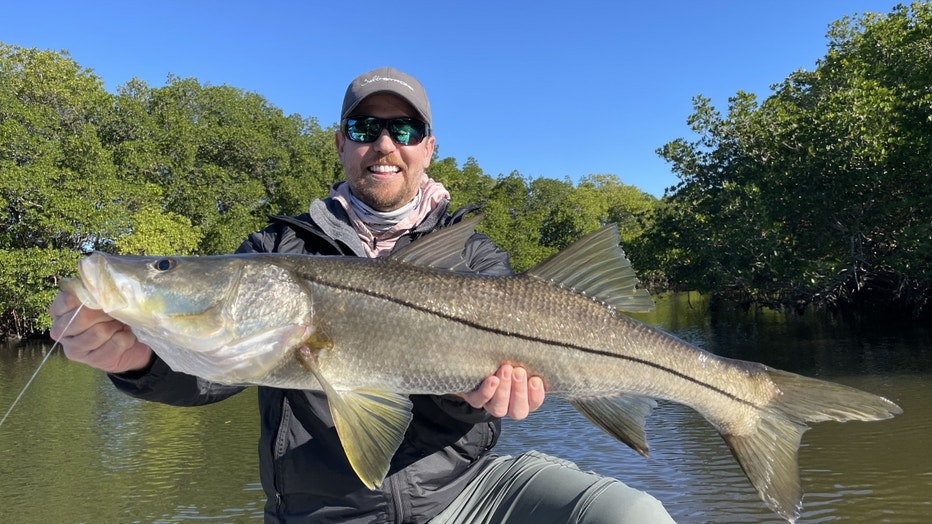
Snook (Credit: Hubbard's Marina)
However, you have to keep in mind the cooler the water, the more opportunistic and lethargic the fish get. This means you have to retrieve your bait more slowly and give the fish the opportunity to feed without expending much -- if any -- energy by presenting your bait naturally as close to the strike zone or feeding area as possible.
Slow-moving soft plastics, swimbaits, live shrimp, and even cut dead baits become more and more productive as waters cool.
Redfish have been steady around the area this past week as well. We are seeing a lot of these fish around the docks, oyster bars, piers and bridges. Plus, the flats and mangrove shorelines still hold plentiful redfish too.
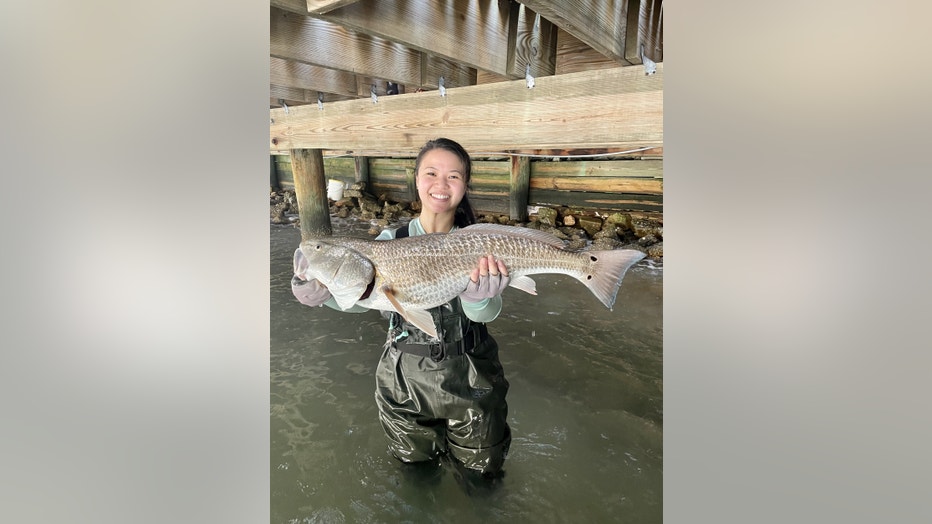
Redfish (Credit: Hubbard's Marina)
Like the snook, you can find them on the dock lights and bridge lights however, they are going to be on the bottom and harder to spot. Large live shrimp working well on our near the bottom or cut pinfish or threadfins too. Soft plastic paddle tails are an angler favorite for the redfish too, but the imitation shrimp moved slowly on or near the bottom is a great option as well.
Trout action has also been good this past week around those edges, cuts, and pockets of the flats. We are seeing some around the passes and choke points of the bay as well. Live shrimp, greenbacks, and soft plastics are a great options for trout. Also, the jerkbaits, when retrieved more slowly, work to get them chewing too.
Trout tend to move a bit shallower as waters cool, but we haven’t seen a big push to shallow waters lately with the warmer trends. That could change a bit with the big fronts coming, but for now, it seems they are holding steady around that 3 to 5 feet range. Dock lines are also holding trout, and dock lights at night are doing well-producing trout action too.
Flounder action is spotty around the area, but you can find them in those sandy patches adjacent to or spread throughout the flats. We are also finding them around the docks and bridges of the passes too. Look for them adjacent to structures on sandy bottom areas, ready to ambush passing baits close to or on the bottom. They are moving in and out of the passes for their near shore spawn this time of year.
Pompano are around the passes, islands of the bays, some sandy passes and cuts too. They like that clearer, cleaner water. They move around a lot as well, making it difficult to hone into their numbers, but some anglers follow the bite as best they can.
Areas like Fort De Soto, Pass-A-Grille, Blind’s Pass, and John’s Pass jetties are good areas to work with pompano jigs. Also around the Dick Misner Bridge, Anna Maria Island, and the cuts of the northern tip of the south side of Tampa Bay.
Near shore
Red grouper action near shore is a little hit-and-miss until you get to the deepest near shore waters.
Closer to 80 to 100 feet of water is where the chances for keeper red grouper in better concentrations exponentially increase. We are seeing them as shallow as 50 to 70 feet of water too, but the better numbers of more keeper-sized fish are in the deeper near shore waters.
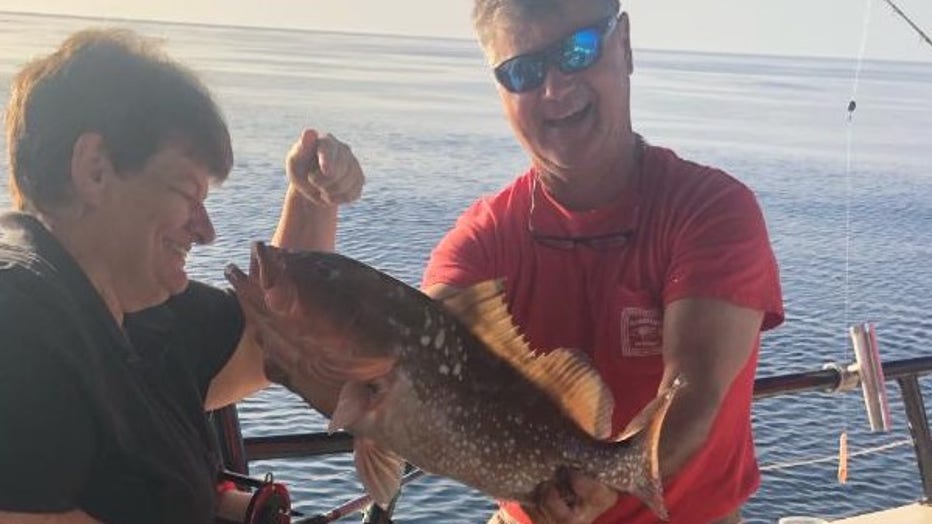
Red grouper (Credit: Hubbard's Marina)
We are seeing them most often on squid strips, pinfish, cut plugs of white grunts, porgies, or gulf perch. Also, double threadfins dropped much more slowly to the bottom to avoid the baits spinning on the way down is a good option for keeper red grouper as well.
Typically, around 40-60lb test and 5-7ot hooks are good options for red grouper and the hook size and leader size is going to be mostly dictated by your bait size and depth of water. The deeper you go, the greater the chance for a bigger red grouper. Thus, bigger hooks and leaders are a good idea. The bigger the bait, the bigger the hook and leader too.
Lane snapper action is on fire near shore, and we are seeing them prolifically around 60 to 100 feet of water, but we do find them shallower and deeper too. Mostly these guys were considered a bycatch. We would see occasionally just a few years ago, but nowadays, we are seeing them become more and a more steady and reliable target species as they proliferate near shore.
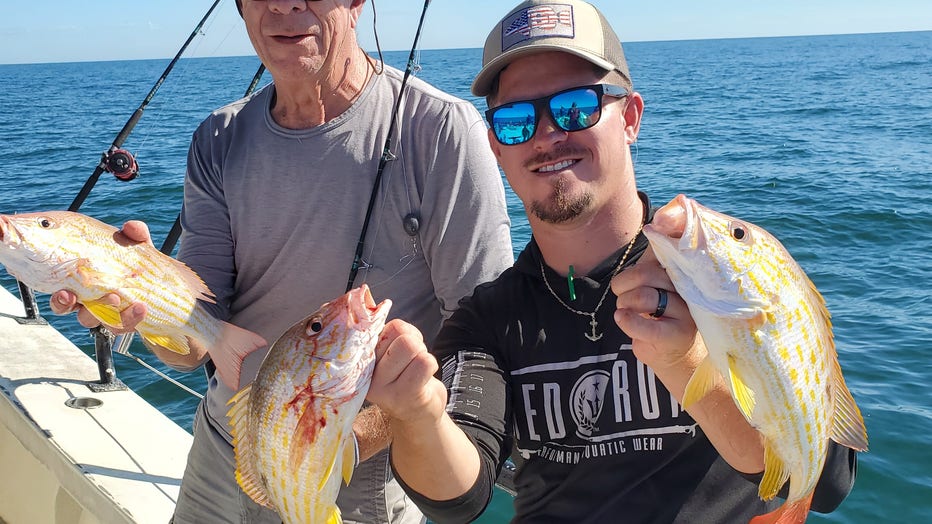
Lane snapper (Credit: Hubbard's Marina)
Using squid, shrimp, or even cut threadfin and smaller hooks and lighter leaders are great options for lane snapper. I would use around 30-40lb test and 3-4ot hooks to target them near shore just like the mangrove snapper.
Speaking of mangroves, we are seeing some large mangrove snapper near shore lately.
They are not super prolific or in big concentrations, but we are seeing some surprisingly large mangroves near shore. Like red grouper, the deeper you go the more mangrove snapper you will see and the greater the chances for finding higher numbers of the mangrove snapper too.
Hogfish action is steady near shore around 40 to 70 feet of water, and we are seeing them most often on the 10-hour all-day trips, but we are seeing them on our 5-hour, half-day too. However, on the 5-hour, we do more drift fishing which makes it a lot more difficult to get large numbers of hogfish. The 10-hour gives us more fishing time, and we anchor fish more frequently allowing us to target the hogfish a little better on those trips.
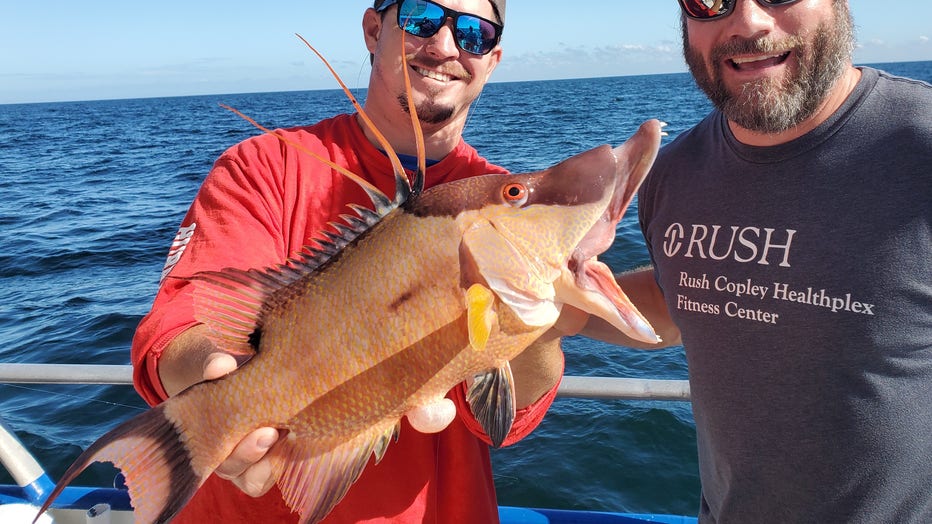
Hogfish (Credit: Hubbard's Marina)
Offshore
Red grouper action is going extremely well for us in the deeper offshore waters. We are seeing some really fat red grouper while fishing 150 to 200 feet of water, but we see them consistently around 100 to 150 feet of water too.
The deeper offshore waters produce more bycatch of red snapper and gag grouper you have to release while targeting red grouper, but we also see the scamp grouper and fatter red grouper.
While fishing shallower under 120 feet, you are much less likely to run into concentrations of red snapper and the red grouper bite is going well there too. Look for them with the same bait we are using and recommending for the near shore red grouper.
However, the leader-sizes are bigger, around 50-80lb is typically a better idea. Hook sizes are also bigger offshore too around 6-8ot hooks are a good idea offshore. The bigger the bait and the deeper the water like near shore the bigger the leader and hooks.
Mangrove snapper action is fired up offshore right now. We are seeing some monster mangrove snapper in a big overall size while fishing deeper offshore waters. We are seeing like a 5-6lb average on the mangrove snapper which is incredible. Closer to 150 feet and beyond we are seeing a steady mangrove bite with an incredibly larger average size. Around 40-50lb leader is a good idea with around 5-6ot hooks. Cut threadfins are working extremely well on the double snell rig.
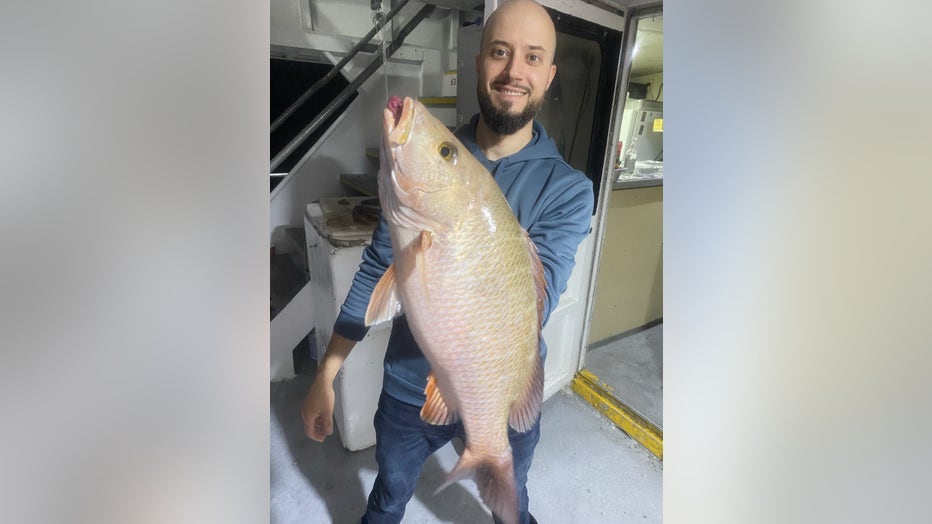
Mangrove snapper (Credit: Hubbard's Marina)
Scamp grouper is going well out in the deeper near shore waters beyond 150 feet of water with the smaller pinfish, 4-6oz diamond jigs, and squid strips. However, we see them most often while targeting the mangrove snapper on cut threadfins fishing that double snell set up.

Scamp grouper (Credit: Hubbard's Marina)
Blackfin tuna are pretty thick out there offshore right now. We are seeing them on flat lines while trolling, and also while vertical jigging.
Wahoo action is sporadic but present offshore too, mostly on trolling, but you can find ‘em occasionally on flat lines. Kingfish are out there offshore as well. Don’t forget the flat line with wire while offshore fishing to get a shot at these guys!
Don't be a fool; bring a venting tool and/or a descending device
It is so important to keep in mind the importance of dead discards and discard mortality when engaged in near shore or offshore fishing. If we can all work together to change the cultural norms near shore and offshore, we can all help to improve our fishery and our fishery access over time.
How many do you know right now that are all for catching and releasing snook, redfish, and trout but will be the first in line to kill a mangrove snapper, gag grouper or red snapper and the attitude completely changes when discussing these offshore species?
Plus, the same person inshore that will hold their breath and wet their hands before handling a breeder snook will go offshore and then cull through 20 red snappers before keeper their two red snapper they deem large enough to fill their two-fish bag limits while the other 18 they released will often end up suffering fatal damage if not properly descended or vented?
Please help us to spread the word on the importance of descending or venting your released fish. Descending devices are most easy to use and quick to pick up on their use and are most effective for most anglers. However, an expert and precise angler with proper training and tons of experience can use a venting tool properly with similar outcomes. However, a venting tool requires you to pierce the fish while most descending devices are much less invasive.
While using a venting tool it is imperative you pierce them in the exact right spot, and you do not go but a quarter-inch or less in the fish. Most venting tools require you to ‘choke up’ on the tool to prevent over-penetration into major organs.
When fishing deep water, especially in the sweltering summer months, please make sure to treat all fish intended to be released like that breeder snook inshore and minimize the time it takes you to get him from the bottom to the boat using heavier proper tackle not an ultra-light spinning reel. Then once onboard, minimize the time out of the water. Then use a proper dehooking tool, and then for the love of God, use a descending device or venting tool PROPERLY to ensure that fish has a chance to live another day.
Three things will help ensure the survivability of those fish released offshore.
- Making sure they are brought up quickly and do not expend all their energy in the fight.
- Make sure they are unhooked smoothly, easily, and as quickly as possible.
- Finally, make sure they spend the least amount of time at the surface at negative pressures where barotrauma exponentially increases its effect with each passing second.
Also, keep in mind when the water is warm there is less dissolved oxygen content, and the chances of barotrauma increase even more while its effects can be even more deadly.
CHECK OUT THE NEW WEBSITE and marketing campaign to get your own FREE descending device and more information on mitigating barotrauma and barotrauma issues! Do not forget to use the hashtag #ReturnEmRight to help spread the word too on fish you catch and release offshore -> https://returnemright.org/
State survey to improve recreational data and access
It is imperative that you have your gulf reef fish survey endorsement on your fishing license if you are a private recreational angler or diver fishing from a private boat anywhere in Florida who intends to harvest, attempt to harvest or possess one or more of the following reef fish species: mutton snapper, yellowtail snapper, hogfish, red snapper, vermilion snapper, gag grouper, red grouper, black grouper, greater amberjack, lesser amberjack, banded rudderfish, almaco jack, gray triggerfish, Gag grouper, Red grouper, Scamp grouper, Mangrove snapper, Lane snapper, Kingfish, Tuna, or Mahi mahi.
Here is all the information and more on that program and how you can sign up -> https://myfwc.com/fishing/saltwater/recreational/state-reef-fish-survey/
TERMS OF REFERENCE:
INSHORE – from the back bays out to the bridges and including right on the beaches
NEAR SHORE – From the beaches out to 20 miles, or up to 100ft of water
OFFSHORE – from 20 miles or 100ft and beyond
For more fishing reports, photos, videos and more check out Hubbard’s Marina on Facebook, Instagram, YouTube, or Snapchat. Just simply search "HubbardsMarina" and do not forget our family motto, "If you’re too busy to go fishing, you’re just too busy!

